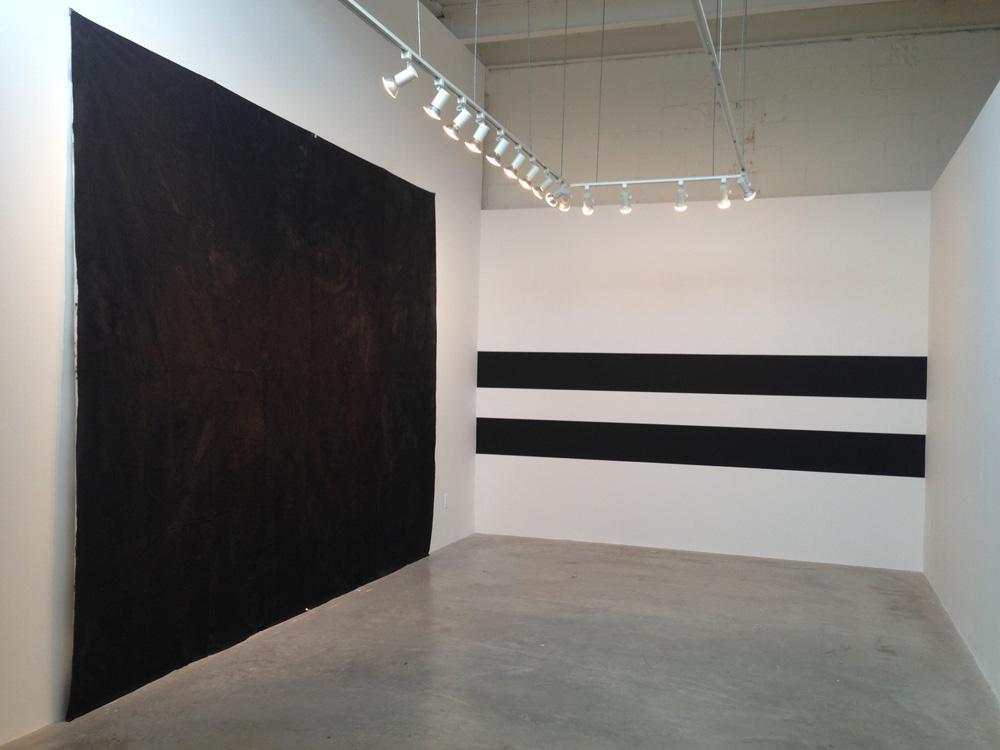There’s a pungent smell hanging in the air at Diaz Contemporary these days. No, it’s not the aroma of the old abattoir situated kitty-corner to the gallery—after nearly 100 years in operation (and perhaps one-tenth of that time spent wrinkling the noses of an increasing number of local condo dwellers and gallery goers), Quality Meat Packers went bankrupt this spring.
No, the odour now wafting through Diaz Contemporary is that of art. Or a certain kind of art, at least: the kind of abstract floor and wall pieces that artist Nicole Ondre creates out of materials like linseed oil, asphalt, and still-oozing oil paint.
By using such gooey, smelly, oily materials, Ondre gives new meaning to the term “dirty abstraction.”
Take, for instance, Ondre’s floor piece Double Bind. Here, a mix of linseed oil and oil paint seeps into layers of white, pristine photo-backdrop paper, creating moldy patterns that conjure the unsavoury decay one might see upon the surface of a sidewalk-abandoned mattress.
The effect is further underlined in Ondre’s wall work The Pliable Plane. According to the gallery staff, the artist created this expansive black monochrome by using a layer of oil paint to adhere asphalt onto Tyvek. The effect is not, as in so many black monochromes, of an infinite void, but rather a very present and varied surface.
These aspects of Ondre’s work come across even more strongly when presented in counterpoint with the creations of fellow artist Neil Campbell.
Campbell’s acrylic wall paintings draw on hard-edge and op-art traditions in their graphic clarity while also, in their scale and placement, evoking the gloss of large-scale corporate logos and billboard advertising. His twisty, red-and-black Popeye painted onto an interior corner of the front gallery slips back and forth between 2-D and 3-D, while his own black “monochromes” Plumb (shoreline) and Plumb (interval) in the back gallery wink at distinctions between abstraction and representation.
Curator Christina Ritchie’s pairing of these Ondre and Campbell works is an aggressively stripped-down pas de deux in a summer season full of wide-ranging group shows that sometimes come across more as druggy, drunken dance parties. It immediately had my thoughts pinging between aesthetic oppositions: Pure colour vs. impure colour. The sharp line vs. the moving line. The touched vs. the untouched. The definite vs. the developing.
Still, I wondered if by playing Ondre and Campbell’s works both with and against each other, wider nuances of their practices might be lost. After all, some of those aforementioned summer group shows, though rangy, can present the viewer with connections that come across as pleasantly lateral and happenstance in nature, rather than set into choreographed motion with the flick of a tuxedoed conductor’s baton.
Nonetheless, it’s clear that the pairing of Ondre’s smelly, gritty, oily, tactile, materially oriented approach to abstraction with Campbell’s dry, wry, hard, clean, visually oriented proposal is a potent one.
The show is also a good (and rare) chance for Torontonians to see works by these artists, who have both long been based in Vancouver. (Ondre is now even further afield, pursuing a master’s in Hamburg.)
If it’s possible to access the site before it is inevitably sold to a condo developer, it could be interesting to see what Ondre and Campbell would do with that abattoir.









